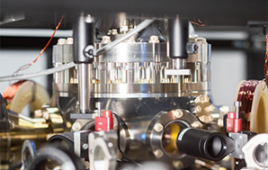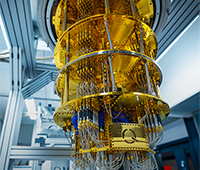Keeping Next-gen Colliders in One Piece
 |
| Part of the Large Hadron Collider at CERN |
Controlling huge electromagnetic forces that have the potential to destroy the next generation of particle accelerators is the subject of a new paper. So-called ‘wake fields’ occur during the process of acceleration and can cause particles to fly apart. The particles are travelling at extremely high energies and, if they are subjected to these wake fields, they can easily destroy the accelerators.
In his paper, “Wake field Suppression in High Gradient Linacs for Lepton Linear Colliders,” University of Manchester accelerator physicist Roger Jones examines research into the suppression of these wake fields. The challenge, he says, is finding a way to suppress wake fields sufficiently while still maintaining a high acceleration field to perform particle collisions.
Jones said: “Wake fields have been carefully controlled and suppressed in the Large Hadron Collider (LHC) at CERN. However, physicists are now looking at what comes after the LHC. An electron-positron collider is the natural successor to the LHC and, it turns out, the wake fields are much more severe in these linear collider machines. Indeed, acceleration of particles to ultra-relativistic energies over several tens of kilometers in the proposed Compact Linear Collider (CLIC), for example, poses several significant accelerator physics challenges to designers of these immense machines. Beams consisting of several hundred bunches of tightly focussed charged particles can readily excite intense wake fields, forcing the bunches to fly apart.”
In his conclusions, Jones suggests two approaches to mitigate for the effects of these extreme wake fields. One approach entails heavy damping, in which the majority of the wake field is sucked out of the collider by structures, known as waveguides, coupled to each cell in the accelerator. A second approach entails light damping, in which a small portion is removed in combination with detuning the cell frequencies of the accelerator.
Jones adds: “Detuning the wake field can be understood by thinking about acoustics. If you have a collection of huge bells all ringing at slightly different frequencies or tones, the amplitude or ‘wave height’ of the overall sound heard will be markedly smaller than that heard if they all ring at the same tone. This method is very efficient and structures built in this manner are known as a Damped Detuned Structures (DDS). Detuning is perhaps more elegant than heavy damping, as it also enables the position of the beam to be determined by the quantity of wake fields radiated by the beam. In this way, a DDS accelerator removes the wake fields and has its own built-in diagnostic.”
The DDS concept was developed by Jones and colleagues during one and a half decades spent working at the SLAC National Laboratory at Stanford University. While at the University of Manchester, he has recently developed this method to apply to the CLIC 3 TeV center of mass collider being developed at CERN. More than 143,000 of these accelerating structures will be needed for the CLIC.
Jones explained: “At this stage, both means of wake field suppression should be pursued in order to thoroughly assess their applicability. Experimental testing, using realistic pulse lengths and at the high gradients planned for the linear collider, will be the final test on the suitability of these techniques.”
Jones has undertaken research into wake field suppression over the last 20 years, the last four of which have been spent at The University of Manchester’s School of Physics and Astronomy and at The Cockroft Institute of Accelerator Science and Technology, based at the Daresbury Laboratory in Cheshire.



